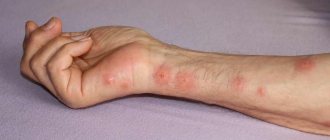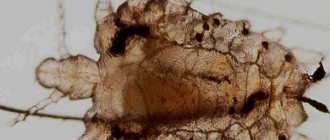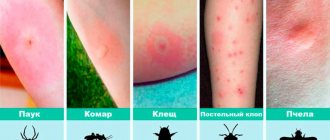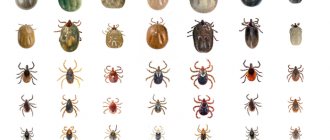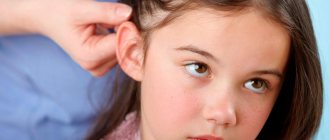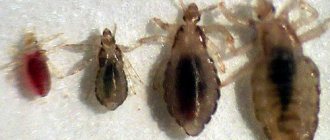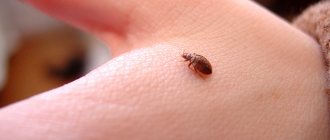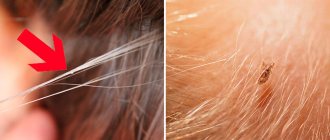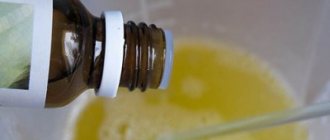How they bite
To begin with, it makes sense to understand how lice bite people. Once in the right place, the insect begins to use sharp stilettos around its mouth. The flea also has the same “attributes”. With the help of these elements, the pest moves deeper into the skin until it reaches the artery.
In this case, the head of the parasite is completely recessed into the human skin, and the body has a vertical position. As the insect penetrates, it secretes a special enzyme that prevents the blood from thickening. It is this substance that allergy sufferers react to.
Attention! The larvae are also capable of biting. However, their activity is not so dangerous for humans: the amount of irritating enzyme in the saliva of individuals is extremely small.
What symptoms appear and how does the patient feel?
Common signs for different types of blood-sucking parasites:
- Intense itching
- Redness on the body - bite marks
- Nits are found on the hair.
But lice bites on the head and pubic area are characterized by another common symptom - the condition of the hair worsens, it sticks together. However, this happens with severe infection, when there are too many pests, and in addition, the person ignores the rules of hygiene - does not wash his head and body.
Then so-called tangles are formed. This is the result of the work of the sebaceous and sweat glands of the head, but there is another factor - an adhesive secretion that ensures the attachment of nits to the hair, and waste products of insects that bite humans.
If there are only a few biting parasites, then a person may not even pay any attention to the itching.
The patient feels severe itching when a louse bites him. If wounds appear, then pain is added. An allergic reaction manifests itself as swelling, which worsens the quality of life and poses a danger. Intense itching interferes with sleep, the person becomes irritable.
What do lice bites look like?
A reliable sign of active activity of individuals is the detection of lice bites on the head and body of a person. The skin in the local area turns red, a protracted center is visualized, and itching and tissue swelling are noted.
With multiple dispersal of parasites, numerous traces of lice bites are noted - the patient’s skin becomes bluish.
When linen lice bite, pimples 2-4 mm in diameter appear on the human body (not the hair part). Most often, such “marks” are found on the patient’s abdomen, shoulders and buttocks. With increased sensitivity of the body, an allergic reaction manifests itself in the form of extensive swelling and redness.
Traces of pubic parasites spread to the anus, genitals, and less commonly, armpits, eyebrows and eyelashes. Miniature red spots are found in local areas. Since this type of parasite is small in size, there is no characteristic dot-shaped mark on the pimple.
Traces of vital activity of parasites on the head are not easy to notice. With extensive infestation, lice bites are found on the body beyond the hairline area.
Areas affected by head lice become crusty when scratched. In this case, pimples appear in no particular order - the points are located chaotically.
Symptoms
If we talk about the symptoms, they are not different in anything special and are typical for all parasitic diseases of this kind:
- Redness. The first sign of pediculosis is the appearance of small red spots, which at first are not accompanied by anything. Very often, people do not even suspect the presence of parasites on their bodies, citing the fact that the spots were formed as a result of skin friction, excessive sweating or food allergies.
- Itching. Lice feed exclusively on the blood of their host, on whom they parasitize, and to do this they have to bite through the skin. While the louse is small, the itching is almost imperceptible, but after 2-3 days, the itching becomes unbearable.
- Bite marks. If the problem is not identified in time and treatment is not started, the skin becomes covered with visible wounds. When several lice bite in one place, blood stagnates in the subcutaneous tissue, it does not clot well and a small bruise appears. Thus, on the body you can see small wounds with baked blue blood.
- Nits. Lice tend to multiply and lay small black larvae covered with a white capsule - nits. They are very firmly attached to the roots of the hair and it is almost impossible to wash them. You must use a special brush for combing. How to distinguish dandruff from nits, read on our website.
- Deterioration of hair condition. Every time you bite through the skin, blood microcirculation in the upper layers of the epidermis is disrupted and blood flow worsens. This deprives the hair of adequate nutrition, the hair follicles become weak, begin to come to the surface, and the hair actively falls out.
Interesting fact: lice do not grow in dyed hair. Naturally, parasites can migrate to such hair, but they will not stay there for long. Ammonium thiaglycol, which is included in all paints, has a detrimental effect on insects. But it is worth remembering that lice staining should not be used as a medicine. If paint gets on open head wounds, you can get severe chemical burns and cause allergies.
Differences between lice bites and other insect bites
It is usually difficult to tell right away whether lice are actively biting a person or other insects. Bites of pubic and head parasites are characterized by a common difference - spots appear regularly. Other representatives are not interested in constantly returning to the hair growth zone.
This feature of pests is explained by the specific structure of the body - only lice can boast of special hook-shaped growths on their paws, which facilitate the process of moving individuals along the hair.
Body lice bites are not so easy to distinguish: their marks are approximately the same size, they are located in the area of the buttocks, abdomen, arms, etc.
The peculiarity of lice bites of this type can only be considered their chaotic arrangement.
If you compare a louse with a bug, the latter leaves behind a chain of red dots on the body of the victim.
Body lice
Body lice bites are often confused with bed bug or flea bites. Parasites live on clothing and can bite the entire body. This species is descended from the head louse. He has adapted to living in the seams of his clothes. It also lays eggs there. The pest can bite the human body once every four hours. These wounds itch a lot and make it difficult to sleep.
Interesting!
In 1909, Charles Nicole discovered that the body louse is a carrier of typhus.
Body lice causes:
- formation of blisters, boils, papules;
- the occurrence of roughening of the skin;
- the appearance of pigment spots.
To understand that a parasite infection has occurred, it is worth looking at photos of linen lice bites. You can notice that the wounds are mostly located where the clothing is close to the body:
- armpits;
- sides;
- hands;
- lower legs.
With a chronic disease, the entire body is covered with painful wounds. The skin turns red and begins to peel. This type of lice was nicknamed “tramp disease.” The human body, when seriously infested with bloodsuckers, adapts to linen lice and the bite sites cease to cause great concern. But the skin does not become healthy.
On a note!
The dress look does not settle on wool, silk, or synthetics. Pests prefer to live on cotton and flax. Therefore, linen made from these fabrics needs to be washed at high temperatures and ironed.
Lice bites on the body may merge into large bluish spots, but they will not appear on the head. A body louse will not be able to bite the skin among the hair.
Why are bites dangerous?
A lice bite is dangerous due to the possibility of infecting the owner with a serious illness.
Diseases carried by insects include:
- relapsing fever. Manifested by fever, allergic rashes, severe intoxication, jaundice of the skin;
- typhus. Accompanied by destructive changes in blood vessels;
- quintan. Acute infection, manifested in the form of high fever, soreness in muscles and joints;
- tularemia. An infection that leads to damage to the lymph nodes and nearby tissue.
Many argue that pubic lice bites are especially dangerous. This is due to the imaginary ability of pests to carry STDs and AIDS. Since the nature of immunodeficiency is different, we are not talking about the possibility of contracting pathologies through parasites.
Attention! Lice bites on the body and head can cause a severe allergic reaction, which requires prompt attention to specialists.
Types of lice and what their bites look like, symptoms - photos.
Lice are those parasites that have coexisted with humans for a very long time and can be transmitted to people from various animals. They are divided by species, based on their habitats:
- clothes;
- pubic;
- head ones
Pubic lice bites resemble an allergy or a symptom of some disease, as seen in the photo below.
Bed lice leave other traces of their presence and they look like this.
Head lice are the most difficult to detect ; they initially leave red dots, which, as the infestation increases, merge into blue spots that do not disappear with pressure. Once the lice are cured, the spots will go away after some time. Healing usually takes about one week if all parasites and their eggs have been completely removed from the surface of the body.
NOTE: These insects vary in size and can range from 0.5mm to 3mm in size. It is best to examine the suspected affected areas with a magnifying glass so as not to miss the parasite. During feeding, their transparent bodies become reddish in color, which also helps to detect them. The main thing is to start searching in bright light, ideally daylight.
Any type of lice leaves, among other things, traces of its presence in the form of small brown dots on clothing or bedding. The more lice there are on the host's body, the greater their number.
All types of lice are discussed below in more detail, as well as ways to combat them.
Treatment
Lice bites are a reason to consult a doctor in cases of a severe reaction: multiple rashes, fever, headache and other alarming symptoms. Before meeting with a specialist, a person can relieve symptoms on their own.
First aid
The first aid algorithm for pest bites is simple and includes the following steps:
- Wash the affected area with soapy water.
- Use a disinfectant and dry the affected area (you can use any alcohol-containing composition).
- Treat each lice bite with Fenistil (you can replace the product with Rescuer).
How to relieve itching
You can relieve the itching of an insect bite with any cream or ointment containing menthol, as well as anti-inflammatory medications.
Among the well-proven drugs were:
- Nezulin. Has a natural composition. The drug is not contraindicated for the treatment of children. Has a repellent effect;
- Bepanten. Used in the treatment of bites and protection against pests. Heals and relieves signs of inflammation;
- Menovazin. An effective representative of antiseptics, cools well, relieves inflammation;
- Levomekol. The drug contains an antibacterial component. Fights microbes, eliminates itching, redness, promotes accelerated cell regeneration.
All listed medications are prescribed by a doctor. Additional drug therapy is required for the patient only in cases of severe head lice.
Attention! Since we are talking about a contagious form of the disease, throughout the entire therapeutic course the patient should limit his contact with strangers and observe the rules of personal hygiene.
Video
Video instruction. How to get rid of lice and nits at home.
Ftiriaz
The pubic louse or louse lives on the pubis and armpits. The parasite attaches to the base of the hair and hardly moves. Pubic lice bites look like small bluish spots and cause unbearable itching.
Interesting!
The pubic species is not adapted to life on the scalp. Its paws are such that they can cling to hair having a triangular cross-section.
A symptom of a severe pest infestation is the appearance of marks in the lower abdomen and buttocks. You may notice brown spots on your underwear – these are traces of the pest’s activity.
Phthiriasis is not easy to detect. The parasite is small in size and hides at the very base of the hair. But after feeding, the louse acquires a brighter color and reveals itself. Pediculosis pubis is often confused with a genital infection, because in both cases there is severe itching in the genital area. But the parasite reveals itself through bite marks. A lice bite looks like a bluish spot that does not disappear when pressed.
The louse itself is easy to spot if you take a magnifying glass.
Danger of lice
Lice bites provide a lot of inconvenience and discomfort.
- The affected areas are very itchy. The itching intensifies at night, as parasites become more active at this time.
- A person suffers from insomnia, decreased ability to work, daytime drowsiness, and headache. Constant itching makes it difficult to concentrate and irritates the nervous system. Puts you in an awkward position in front of others.
- Scratching leaves scratches and infection enters the wounds. Ulcers and lumps appear. The addition of a secondary infection is dangerous for the development of other dermatological diseases.
- The substance that the louse injects into the human body provokes a severe allergic reaction. It manifests itself as unbearable itching, redness, burning, and rash. If a person has a tendency to allergies, the situation requires immediate treatment. Antihistamines and antiallergic drugs are prescribed.
How to get rid of bed lice?
Even the pest’s high adaptability to unfavorable conditions does not allow it to survive with the correct control methods. At what temperature do lice and nits die? Any temperature above 45 and below 5 degrees is fatal for pathogenic individuals.
Actions that result in the death of lice and nits:
- Timely and high-quality washing of clothes. Since lice die at temperatures above 45 degrees, this point must be taken into account when setting the mode on the washing machine;
- Ironing things on both sides;
- It is necessary to dry laundry and other things outdoors, preferably in direct sunlight;
- Treatment of clothing with special means.
The best way to get rid of parasites is to stay clean. By missing the early stage of their appearance, destruction will take much longer. There are many chemicals that can kill parasites.
To achieve the desired result, the struggle is carried out as follows:
- Use of insecticidal preparations in the form of a spray or solution. They destroy many types of pathogenic microorganisms. Representatives - Medifox (as in the photo), Pyrethrum;
- Tar soap is a simple and effective remedy after which bed or linen lice will not survive. All clothes and linen are soaked with it. It is acceptable to use as an antiseptic, lubricating itchy skin surfaces;
- 3 day freezing method. It is used in cases where a person returns home from a long business trip or purchases used clothing. In winter, they are hung outside for three days;
Important: adherents of folk methods suggest soaking clothes in kerosene, which will 100% destroy parasites. However, this method leaves a specific smell, it is not possible to remove it, and accordingly, things become unusable.
How to treat bites and relieve pain?
First of all, you need to start fighting lice. Underwear specimens are found on the seams of clothing, head specimens are found in the hair, and pubic specimens are found in the groin. If lice bite a lot and often, and the body’s reaction is quite serious, the affected areas are treated:
- Soap and water
- Alcohol-containing solutions; propolis tincture in alcohol is especially recommended for this purpose.
- Symptoms of inflammatory processes are relieved by Fenistil gel, Rescuer ointment, and the well-known remedy – Zvezdochka – will also work.
- If an allergy has developed, bites on the body are treated with Menovazin.
The more linen or other lice bite, the more intense the symptoms. If signs are present: nausea, headache, fever, you should consult a doctor.
You can relieve the symptoms of an allergic reaction when bitten by linen or other types of lice using antihistamines: Loratadine, Diazolin. However, you should not take them on your own. The doctor will prescribe the required dosage.
Related posts:
First aid for lice bites
The indisputable truth is that as soon as insects are discovered, you need to begin eliminating them. This applies to both the patient himself - treatment with insecticides, combing out nits - and his environment. Along with the treatment, it is mandatory to carry out a complete sanitization of the apartment with cleaning of furniture, washing bed and underwear at maximum temperature, etc.
If it is not possible to start treating head lice right now, and the bite sites are very disturbing, you can do the following:
- Treat wounds with soapy water and any alcohol tincture - calendula, propolis, etc.
- As an antiseptic, wounds are treated with Rescuer ointment.
- The most common Star, a balm known to everyone since childhood, helps relieve itching.
- To avoid allergies, apply Menovazin ointment to the skin.
- Go to the pharmacy for remedies for head lice and, while the patient is resting, begin sanitation.
